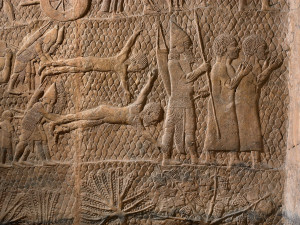 Throughout history, there have been occasions when the intentions and grand scheming of one distant nation have caused repercussions across a wide adjoining region. Such was the case when the city states across the Northern and Southern Kingdoms of the Levant suffered at the hands of the expanding ancient Assyrian sphere of influence. We learn about these encounters in 1st and 2nd Kings of the Bible with corresponding and mostly corroborating discussions from inscriptions on monuments from the mid-late 9th c. BCE reign of King Shalmaneser III. While the westward incursions of the Assyrians continued nearly unabated, the actions came to a head in the late 8th century, when King Sennacherib’s army swept across all cities in its path right up to the doors of Jerusalem, where the destructive wave was stopped. Here again, we are provided with stirring biblical accounts and matching Assyrian evidence from Sennacherib’s prism tablets and inscriptions and graphic depictions on the walls of his Palace Without Rival, at Nineveh (now Mosul), in northeastern Iraq.
Throughout history, there have been occasions when the intentions and grand scheming of one distant nation have caused repercussions across a wide adjoining region. Such was the case when the city states across the Northern and Southern Kingdoms of the Levant suffered at the hands of the expanding ancient Assyrian sphere of influence. We learn about these encounters in 1st and 2nd Kings of the Bible with corresponding and mostly corroborating discussions from inscriptions on monuments from the mid-late 9th c. BCE reign of King Shalmaneser III. While the westward incursions of the Assyrians continued nearly unabated, the actions came to a head in the late 8th century, when King Sennacherib’s army swept across all cities in its path right up to the doors of Jerusalem, where the destructive wave was stopped. Here again, we are provided with stirring biblical accounts and matching Assyrian evidence from Sennacherib’s prism tablets and inscriptions and graphic depictions on the walls of his Palace Without Rival, at Nineveh (now Mosul), in northeastern Iraq.
With an ironic stroke of misfortune, fate has decreed that the historically important and culturally rich remnants of that ancient Assyrian power shall now themselves be purposefully targeted for demolition, with the sole purpose of wiping the sculpture and architecture of that people from archaeological records–and thus from the pages of history. Fortunately, we have the ability to document and preserve archaeological evidence digitally so that future generations can continue to study, learn from, and revisit the past in unprecedented detail and precision. 3D computer modeling of the Assyrian citadels at Nimrud and Nineveh has become eerily relevant lately not only for understanding the empire’s capital cities, but also for envisioning the biblical stories that were turned into historical realities by the 19th-century discovery of Assyrian sites and accompanying inscriptions.
We invite you to watch our series of narrated videos and look at the accompanying descriptions, static images, and bibliography relating (1) the status of the Assyrian capital at Nimrud in the 9th c. BCE, during the time of Shalmaneser III, and (2) the later capital at Nineveh during the 8th c. BCE in which Sennacherib had tales of his conquest and destruction of the fortress at Lachish (now in southern Israel) carved across the walls of one room in his Palace Without Rival, an episode from his third campaign across the Levant chronicled also in several passages in the Bible especially in reference to his subjugation of King Hezekiah of Jerusalem.
